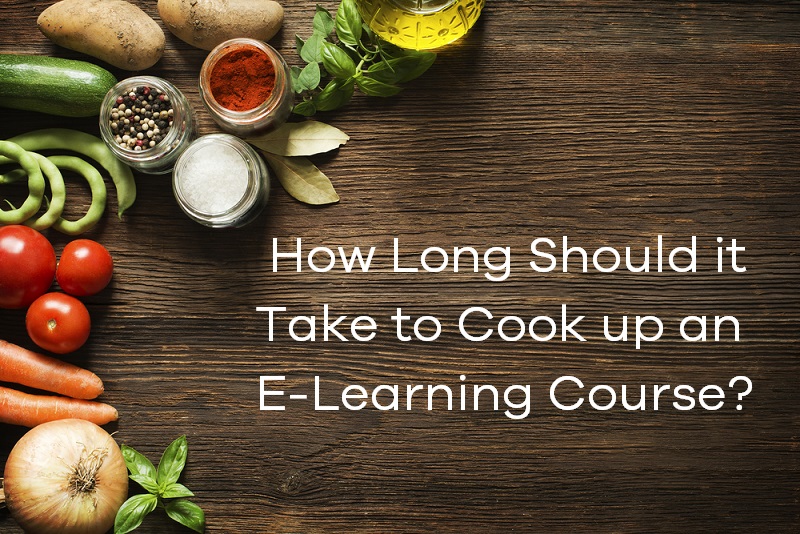Blog
The Legendary Bad e-Learning at Sleepy Hollow, Inc.
By Edmond Manning, Senior Instructional Strategist Quick! Answer this: how long will it take you to make dinner tonight? Without too much effort, you ...


How Long Should it Take to Cook Up an E-Learning Course?
By Edmond Manning | August 06, 2015 | Custom Learning | 0 Comments
By Edmond Manning, Senior Instructional Strategist

Quick! Answer this: how long will it take you to make dinner tonight? Without too much effort, you can probably form a quick answer. Thirty-five minutes. An hour. Or are you microwaving leftovers tonight, which means you set the microwave timer to 3:33 and wait until you see cheese explode through the glass door before you yank it out.
Of course, if you’re eating out tonight, you’re probably not worried how long it takes—it takes how long it takes.
However, if a conference room full of stakeholders and 100K were waiting on your answer, you would certainly pause and after careful consideration, answer: “It depends. I need to gather more information.”
Specifically, it depends on:
- If you have to stop at the store first
- If the meat is frozen
- Whether you're making lasagna or hot dogs
- How many people you're serving
- How much time you've allotted for the entire dinner experience (if you're running to softball practice, it might be a take-out-burrito evening)
- How well you cook and the equipment available to you
- How formal tonight's dinner is (Thanksgiving dinner is very different from Thursday's binge-watching Netflix meal)
Certainly, there are other dependencies not listed. So while you may have a gut reaction to the "average time" to cook dinner, the reality is you can't answer this question fairly unless you know some of the dependencies.
Frequently, we’re asked, “How long will it take to create an e-learning course? Just gimmie a gut reaction." It’s definitely possible to have a gut reaction.
Three months. Seven months. Five weeks.
But really, don't we also need to know some of the dependencies on how long it takes e-learning to cook?
Let's look at some e-learning timeline dependencies and see if we can develop strategies for analyzing (and reducing) the time needed.

Interactivity = Lasagna
Fast food satisfies the immediate need to get something "in your stomach," but you can't expect someone to function at peak performance with a steady diet of French fries and pizza.
Page-turners are the equivalent of fast food.
Does that mean quality instructional interactivity must always be the equivalent of a 12-course banquet? Absolutely not— instructional interactivity can be homemade meatloaf, a Cobb salad, or grilled salmon. It's not that instructional interactivity is 'fancy,' it's that it's homemade and more nutritious (because it’s fitted to the learners’ exact needs as opposed to rigid, fits-all training coming out of a box). And realistically, 'homemade' often translates into more time to create than microwaving dinner.
But how much time? It’s hard to estimate accurately without actually making the dish. I remember deciding to make a butternut squash risotto because I liked the picture in the cookbook. I was very proud of myself for starting some scratch. I purchased a giant butternut squash. Dragged it home. It took me the better part of an hour to peel and dice that darn thing! I had no idea it would take so long (having never peeled one before).
Rapid prototyping allows you to create a sample before committing to the whole experience. Rapid prototyping is making a sample lasagna sauce before committing to making four pans of lasagna. If it’s not what you wanted/expected, you start over.
Project Scope = Entrée Variety
The more unique instructional interactions you add to your menu, the more time is needed. Obviously, if for one Tuesday night dinner you're grilling tuna kabobs, baking lasagna, AND creating a cheese fondue as your three main entrees, you need to plan more time for these diverse creations. (And as an aside with this metaphor, how much can learners stand to eat with your focus so widely spread? But I digress…)
If you have twelve different instructional interactions in your e-learning course, it's simply going to take longer. While that may seem like a no-brainer, the very common problem that arises comes from fixing a timeline FIRST and then deciding how many instructional interactions to create. The timeline needs to consider unique instructional interactions before promising, "We'll roll this out in three months." Or, you tailor the instructional interactivity to the timeline you have.
Now consider how a person cooks dinner. You don't grill the tuna steaks, then start the vegetables and cook them to completion, then begin baking a cake for dessert…instead you strategize which items will take the longest and begin them first. Start mixing the cake first—when it's in the oven, cut up the veggies, fire up the grill, etc.
Plan your e-learning timeline accordingly. Through rapid prototyping you uncovered which interactions are the biggest and require the most attention. Now create your schedule to accommodate the different phases of development. You don't want to cut vegetables the exact same time you're mixing cake batter. It's not efficient and strains resources. Same applies to your unique interactions. Schedule the timeline so your team resources aren't overextended and giving poor attention to their responsibilities.
Team Skills = Chef Abilities
When you ask your ten-year-old nephew to make dinner, you instinctively know that you could be eating at 9 PM and it’s likely hot dogs will be involved. It's simply a fact—the timeline depends on the abilities of the food preparer. The only place you probably don't have to consider the cooking-speed ability is in a restaurant. (Even at restaurants, we all have the occasional horror stories about the meal that took a full hour to come to table and nobody even brought us drinks or bread!)
Create the e-learning timeline based on instructional interactivity and the scope and then factor in the abilities of your development team. Involve them in planning—find out where they think they'll struggle, need more time, etc. Account for stakeholder turn-around-time and be sure to plan for at least one or two unexpected delays. Why? Just because sometimes you need to race to the store for more butter or you absolutely have to stop and wash pots and pans. It happens.
Project Delays = Dinner's Burning!
It's obvious when dinner is burning—the house smells terrible. Delays in development of your project have the same impact as burnt food—it's just a different form of 'tastes bad.' When you start cooking a meal and then quit —turn off the oven burners, put everything in the fridge and come back to it a day or two later—there are subtle changes in the quality of food. The cut veggies are now soggy, the meat has absorbed the cooking oil, so now it's greasier, etc.
The same can happen on e-learning projects when delays occur. You lose the freshness of enthusiasm. Very often, you lose the original vision. The development team becomes less enthused and wonders when the next 'slow-down' will occur. Or, you may lose members of the development team, so that Chef #2 is implementing Chef #1's vision.
While unanticipated project delays can’t be planned for, there are options. You can attempt to anticipate objections from legal and compliance and other key stakeholders.. You can look at other rollouts, company initiatives or anything that might get in the way of your ‘dinner’ and anticipate these in your timeline.
The best chefs are aware of everything happening in the kitchen at once, even if they delegate specific tasks. Stay on top of the department and people dynamics so you can anticipate problems before they arise.
And Serve
Creating a realistic e-learning course timeline is not as difficult as duck l'orange with a mint cranberry sauce. You just need to know what exactly it is you're making, and plan the instructional interactivity accordingly. Manage the scope as you would a dinner menu, and evaluate who's cookin'. Timelines can be as easy as mac n' cheese if you're skilled in the kitchen.
Bon appétit.
LIKE WHAT YOU'VE READ? SHARE THE KNOWLEDGE WITH THIS READY-MADE TWEET!
CLICK TO TWEET: How Long Should it Take to Cook Up an E-Learning Course? http://hubs.ly/H012NdY0 #aiblog @customelearning

About the Author: Edmond Manning
Edmond Manning, senior instructional designer for Allen Interactions, has more than 20 years designing interactive e-learning experiences on instructional topics including: software simulation, medical ethics, supervisory skills, and selling/presentation skills, and gosh, a whole bunch of others. He has helped mentor and grow e-learning departments, worked as a business consultant, independent contractor, and instructed the ATD e-Learning Instructional Design Certificate Program for more than a decade. Edmond has a master's degree from Northern Illinois University in instructional technology.
Comments
Would you like to leave a comment?
Related Blog Posts

By: Edmond Manning | Oct, 2015
Category: Custom Learning

Blog
Hold the Phone (training)—5 Questions to Ask First
By Edmond Manning, Senior Instructional Strategist Quick! Answer this: how long will it take you to make dinner tonight? Without too much effort, you ...
By: Edmond Manning | Dec, 2015
Category: Custom Learning

Blog
Five Tips to Battle E-Learning Project Constraints
By Edmond Manning, Senior Instructional Strategist Quick! Answer this: how long will it take you to make dinner tonight? Without too much effort, you ...
By: Edmond Manning | Sep, 2015
Category: Custom Learning


